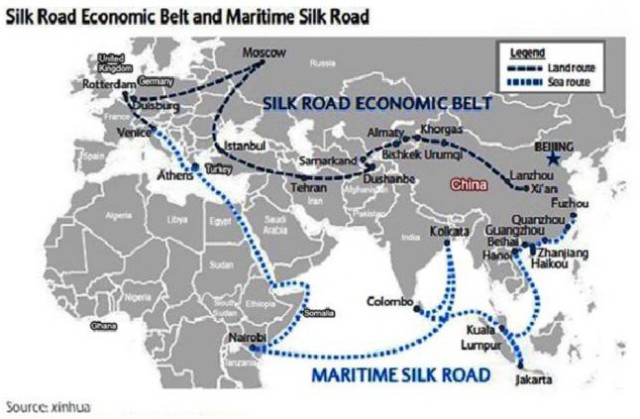The Chinese leadership has embraced the Belt and Road initiative to be built in parallel with one another. According to the action plan of the National Development and Reform Commission, a joint body under the ministry of foreign affairs and ministry of commerce, unveiled in March: “The Belt and Road Initiative aims to promote the connectivity of Asian, European and African continents and their adjacent sea, establish and strengthen partnerships among the countries along the Belt and Road…The connectivity projects of the Initiative will help align and coordinate the development strategies of the countries along the Belt and Road, tap market potential in the region, promote investment and consumption…” The list is an exhaustive one, but it is safe to say that China wishes to create a modern day version of the ancient Silk Road.
Indeed, looking at what is planned, the new initiative hopes to connect Asia, Europe and Africa and tap into vast economic opportunities that will encompass three continents by means of road and maritime connectivity. Visionary to say the least, some headway has already been made. What has the Western pundits worried is the success with which the Chinese have utilised financial diplomacy to make inroads into the mineral-rich Central Asian region. The same diplomacy has been used to great effect in Africa and is being replicated in Asia. With China sitting on a foreign exchange reserve of an estimated US$3.8 trillion, much can be achieved.
While infrastructure woes can be addressed if resources are made available and China has committed considerable finances to that effect to countries in Central Asia, the problem lies elsewhere. That there will have to be seamless policy coordination with dozens of countries, i.e. intergovernmental policy coordination to negotiate and settle on large-scale projects will be one of the biggest stumbling for the venture. For a trade bloc of this magnitude to function, trade barriers will have to come down which have traditionally been resisted by developing countries.
The whole idea can only work if the governments of participating nations get onboard with their respective bureaucracies to implement the billions of dollars that will go into building the facilities in terms of infrastructure, both land and sea. Beyond infrastructure, there is a whole gamut of other issues that will have to be addressed in terms of developing a “unified coordination mechanism for whole-course transportation, increase connectivity of customs clearance, reloading and multimodal transport between countries”. A similar set of rules, procedures and standards have to be set up for use of port facilities, coordination and maritime logistics which will go hand-in-hand with infrastructure development to handle land and sea movement of bulk goods. Bilateral and multilateral cooperation will have to become the building blocks if this initiative is to get off the ground.
Needless to say, the ‘Belt and Road Initiative’ is by far the most ambitious trading block of the new century. So why is China hedging its bets on the new silk road? According to Fitch Ratings, Chinese foreign trade with the resource-rich but relatively economically backward Central Asia stands at a mere US$24.1billion in 2014, which is about 1% of China’s total exports. Yet if one looks at trade volume, that has risen 680% over the decade 2004-2014 which is more than the 654% increase in trade volume in Africa over the same period. It makes sense for China to invest in this region which is rich in mineral resources, i.e. gas, coal, oil, gold, copper, uranium, etc. Central Asia was the bread basket of the now defunct-Soviet Union. No wonder Chinese FDI is pouring into the region with a new highway connecting Kashgar with Osh in Kyrgyzthan and another between Urumqi and Almaty, Kazakhstan.
The new Silk Road’s journey has already commenced and is now being moulded into the new Initiative. With wages on the rise on mainland China, the country is hoping to export some of its manufacturing base abroad to countries like Bangladesh (for garments). While Bangladesh is moving ahead with special economic zones for countries like China, the finished products will have to be transported back for sale in the domestic Chinese market. This is where road and sea connectivity, as envisioned by China and participating countries in the proposed economic bloc will come into play.
Despite what appears to be a win-win situation for all, there will be considerable obstacles to making the new initiative work. To what extent geopolitics will play a role in derailing this multinational effort is of course open to question; how will, for instance Russia, view increased Chinese presence in Central Asia, which has traditionally been considered the Russian sphere of influence. True, today’s Russia is a mere shadow of the Soviet Union and given the warm relations that exists between President Putin and Xi, the Chinese largesse that will come along with the proposed economic bloc can only work to Russia’s advantage in the near term. Looking beyond Russia, China will have to contend with a wary Turkey and upcoming regional power Iran. For the Belt and Road Initiative to stay its course, the political climate in the region will have to remain relatively stable which has not been one of the strong points of the Central Asian region.
*********************************************************************
The writer is Assistant Editor, The Daily Star.
APRIL 21, 2015


 Syed Mansur Hashim
Syed Mansur Hashim